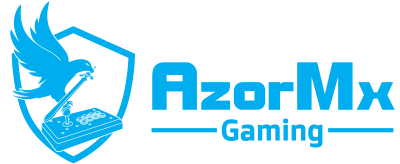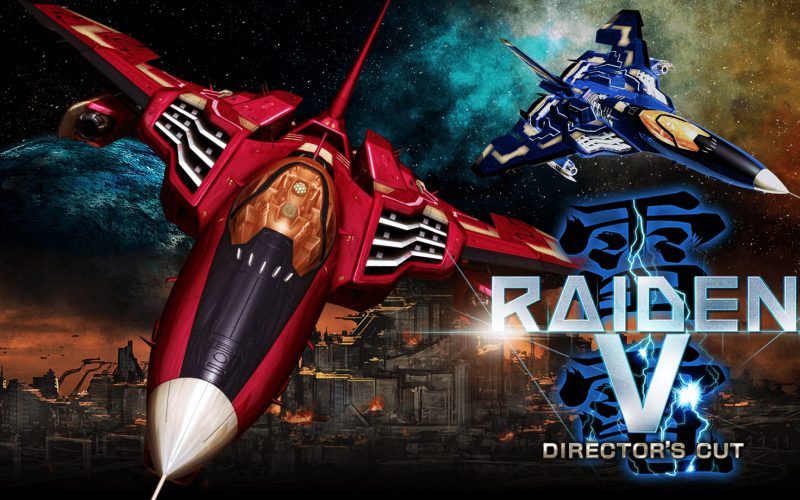The shmup genre hasn’t been a mainstream genre in a long time. To be honest, I don’t think it ever was, even during the arcade days. While we certainly don’t have a shortage of shmups, let alone new release, they usually come from smaller teams. Indies have taken it upon themselves to become a guiding light for all of us. Their creations have been nothing short of amazing! However, we don’t really have anything we could call a “AAA” shmup. We do seem to have the next closest thing: Raiden.
Developer: Moss Co.
Platform: Nintendo Switch
Release date: Jul 25, 2019
Price: $29.99
Tate: Unfortunately… no. This really needed to have TATE
Raiden V: Director’s Cut is a vertical shmup set in a fictional but real world. It claims to be the original bullet-hell, and after playing it extensively I gotta say that I agree. Raiden V features some intense air combat, coupled with giant bosses and some jaw-dropping transitions between areas.
The great intro checklist
Right out of the gate, what caught my attention was the intro. The best way I can put this is that it has everything great about shmups in a short video. It has a great track, it has giant enemies, it has ships and it even has pieces of lore I do not understand! Simply amazing!
Most importantly, it is a very accurate portrayal as to what you should expect from the game. Unlike other shmups, Raiden goes all out in the presentation department, with the story taking a mayor role. Another way I can put this, is that it certainly feels like a considerable effort was placed in every element of the game. Raiden V features a level of polish that very few shmups can claim to have.
Welcome to the customization station
One of Raiden’s strength is the amount of customization you have available for your ship. At the beginning of the game, you can choose between one of 3 different ships: Azuma, Spirit of Dragon and Moulin Rouge. Each of these ships has different stats in terms of attack, defense and speed. They also have their own sub-shot which is always firing along with your main cannon.
On top of selecting a ship, you can arm yourself with 3 out of 9 different weapons. Those 9 weapons are grouped into 3 categories: Vulcan, Laser and Plasma. You can pick, or rather you must pick 1 for each category. The result is a combat style that is unique to you.
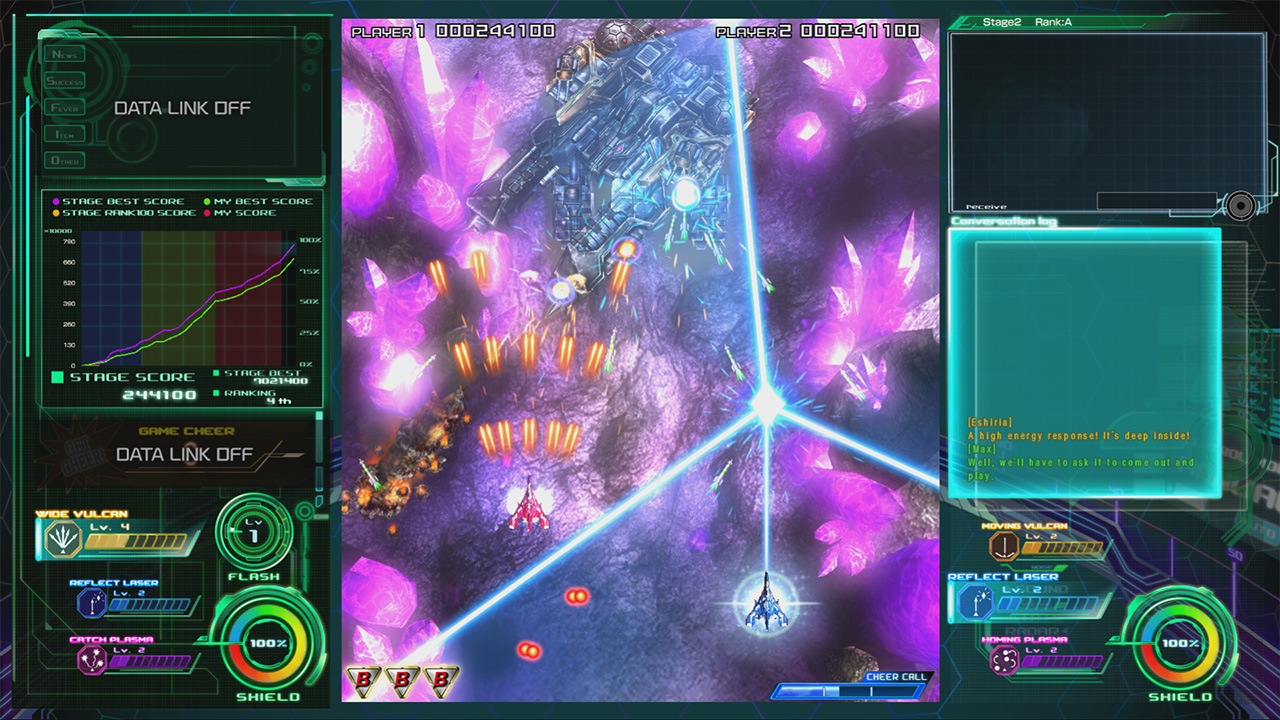
During your play throughs, you will encounter several power-up orbs. These orbs will power up each of your weapons up to 10 times! Each of these orbs can be either red, blue or purple depending on the weapon it powers up. The orbs cycle the colors, with an outer dot indicating a timer until it changes colors. This allows you to control which weapon you want to power up, giving you the flexibility to pick your own style or choose a weapon for the occasion.
The best part is that absolutely no power-ups are lost upon death! This means that you are free to retry to your heart’s content and play at your own pace. Raiden won’t punish you or set you up for failure with an unrecoverable situation.
I didn’t put too much attention into weapon selection at first. I figured it wouldn’t be too relevant, as I would probably just play the entire game with a single weapon, but the advanced scoring mechanics and the rank system were quick to make me second guess my decision.
Ace Pilot
At the core of Raiden V, there are 2 main systems to be aware of: your rank and your flash level. Both of them measure your combat capabilities, although in different ways. Your flash point gauge is a score multiplier that tracks how fast you defeat your enemies. By defeating enemies as soon as possible after spawning, you can earn higher multipliers to increase your flash gauge. By having quick kills, you can raise it to higher levels to increase your score. Your rank, on the other hand, only concerns itself with how many enemies you’ve defeated.
Your rank doubles as the deciding factor of which path you will be taking. Raiden features branching paths with an A, B, C or S version of each stage. Depending on your total destruction rate, you will either move up or down in rank after a stage. While I do not know the exact numbers, I believe having more than 98% destruction rate will increase your rank, 90 – 98% will keep it as is and <90% should decrease your rank. S rank stages are presumably harder than A/B/C stages, with C being the lowest.
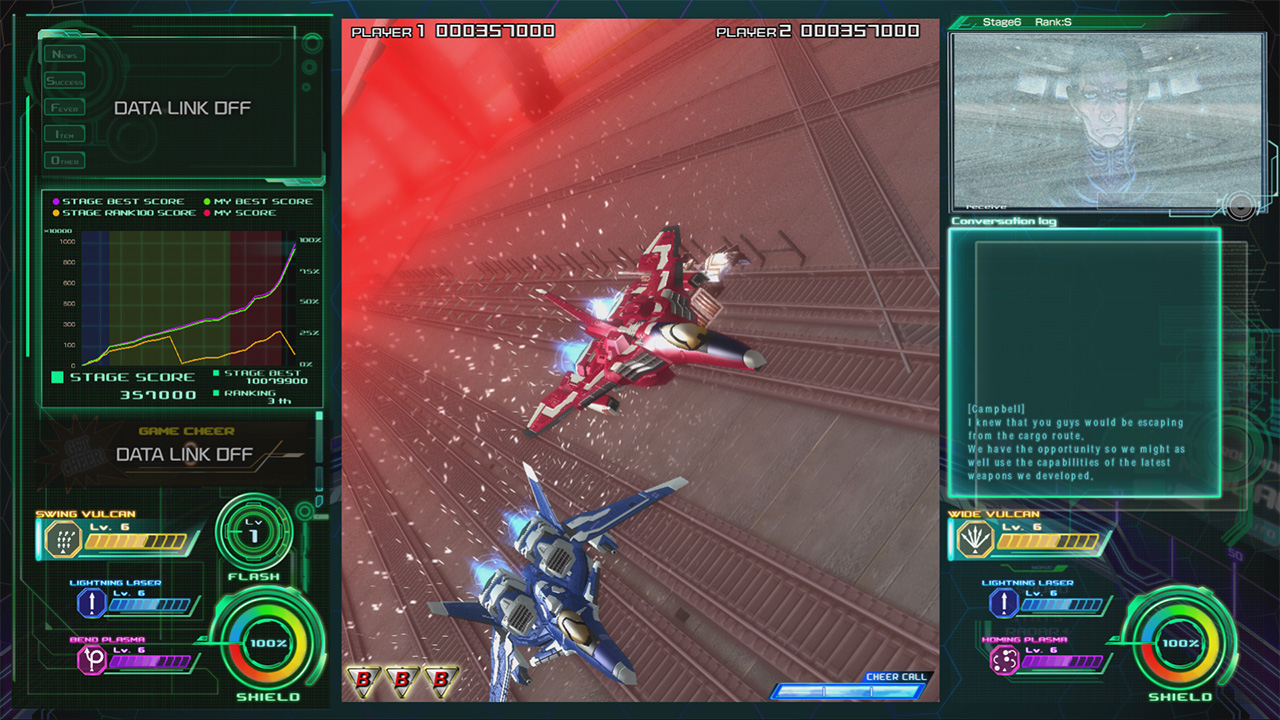
Apart from having a higher score and challenging yourself with the difficulty, the importance of S rank is getting the true ending. In order to truly watch the ending of the game, you need to reach the final stage on S rank using a single credit. You also need to power up your 3 weapons to level 10. Once you meet those conditions, you will be able to challenge the final boss. Alternatively, you could just fulfill the level 10 weapons condition to fight the true final boss.
The best cheerleader
A new addition to Raiden V is the cheer system. By accomplishing certain in-game milestones like a certain number of enemies destroyed, you will get an achievement. These achievements are broadcasted to any players connected to the leaderboards. They can then “cheer” on your achievement to increase your cheer gauge. This goes both ways, as you can also cheer the achievements of your fellow Raiden players.
Once the cheer gauge is full, you can unleash it to clear the screen and gain a drastically stronger sub-shot. Think of it as a devastating bomb, only more devastating and easier to fill. It clears screens and decimates even the bosses.
Perhaps many people won’t think too much of it, but I found it really interesting to know that there’s someone on the other side celebrating my achievements. Likewise, there were times where I left my game on pause to do other stuff, but held on to my controller to provide support for my comrades.
Swift destruction
Everything I’ve mentioned before plays out in the general strategy of the game. Assuming you want to get the best results, you need to know where to hit and how to hit hard. For the untrained eye, most shmups just look like games where you fire away with complete disregard and hope the enemy dies. This is definitely not the case in Raiden.
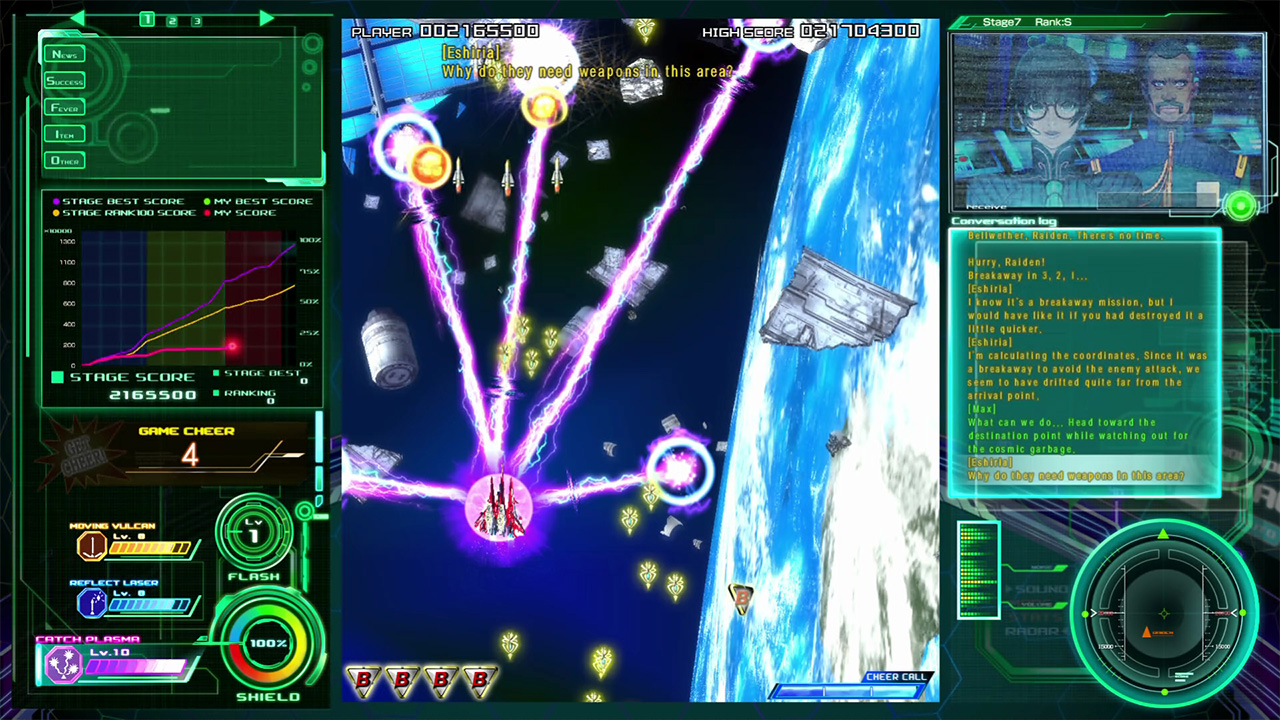
In order to succeed, you must be able to find your rhythm and read the stage. Learn the enemy formations and strategize the quickest kills. Be there before the enemy arrives and take them down before they realize what hit them. If you want to face the true final boss, then you must also learn to juggle your weapons and find the moments to upgrade them. Maxing a weapon and then switching is a recipe for disaster, as you don’t want to be on the later stages with a level one weapon and risk your flash level or destruction rate. With so many weapons and ship types, your strategy to succeed will be unique to you!
Lore galore
One of the main selling points, at least per the game itself, is the story. Raiden V features an extensive story that is fully voiced and occurs as you play the game. This story elements come as the prologue and epilogue scenes, as well as all the events happening mid stage.
As you fly your way to the levels, characters will be advancing the story by having conversations and narrating the current events. The dialogue is available on one of the gadgets located on the right side of the screen. You can read anything you might have missed and even pause to read the on-screen log of events (up to a certain number of events, as the log scrolls to open way for new text).
As for my opinion of the story, I have absolutely no idea of what happened during the game. I played my fair share of runs, but I found it next to impossible to focus on the dialogue while trying my hardest to survive. The voice acting would have been my saving grace, but I found the sound mixing to be the opposite of ideal for listening to dialogue. I even tried lowering the sound effects and BGM to see if I could focus on dialogue to no avail.
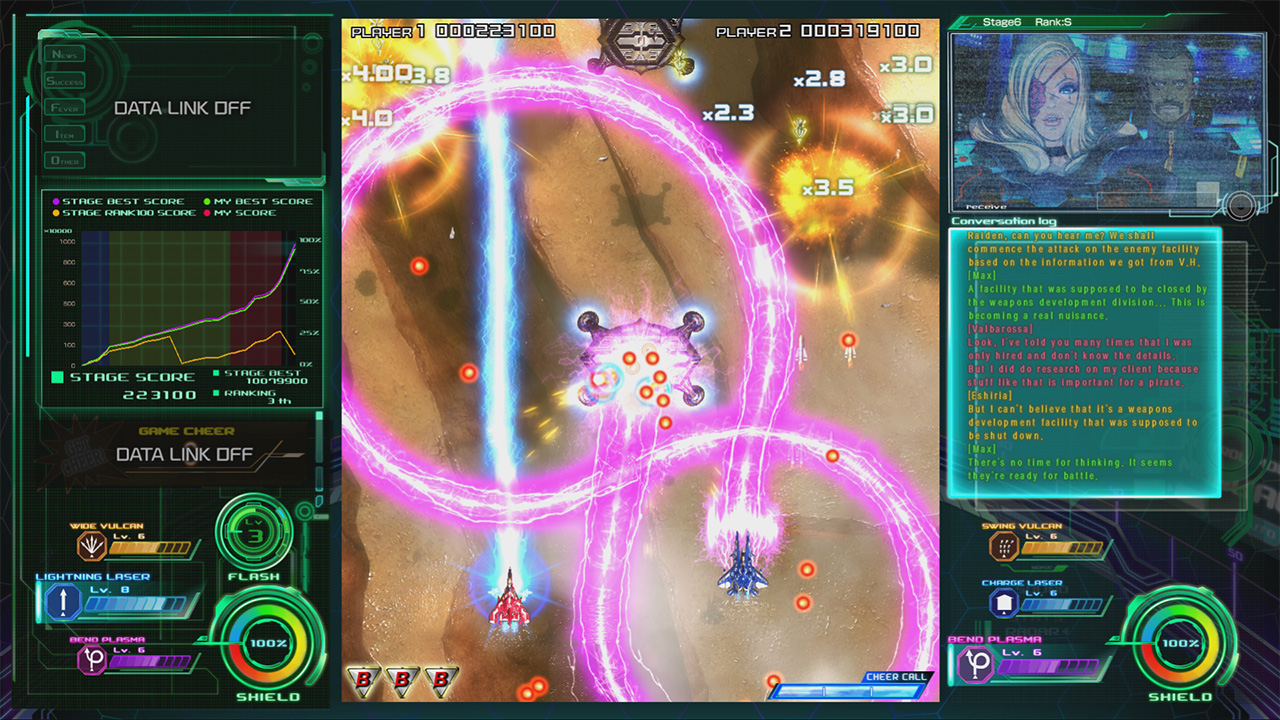
The text is also incredibly small when playing on docked mode. It gets even worse when playing handheld.
The worst cheerleader
Out of all the voices, Eshiria’s was the one who got on my nerves the most at the beginning. Other than having her role as navigator on the plot, she also critiques your gameplay. In-between stage scenes, she will provide commentary describing your gameplay. She will be quick to point out if you did well, but also if you did poorly. On my early runs, when I was still learning, it would tilt me to listen to her complaining to me about stats I did not understand.
And perhaps, a huge part of my problems was a lack of understanding of the game mechanics. I listened to her complain about my destruction rate without knowing it was about my rank. She also complained about destruction speed without me knowing it was about the flash point.
The problem is that the game never bothered explaining any of its mechanics to me. I really looked around for some sort of tutorial to no avail. I had to resort to 3rd party resources. While that isn’t uncommon, I really don’t like games with obscure mechanics that can’t be discerned in-game.
Once I got better and consistently reach the S levels, I finally started to value her advice. Of course, I wouldn’t count on everyone reaching the same enlightenment as I did. In my opinion, her comments would more often than not add insult to injury. Once again, it’s not really the commentary, it’s the fact that none of what she said made practical sense until I started digging on the wiki.
Gadgets and the screen real estate
Perhaps the worst omission from Raiden V is the lack of a TATE mode. Vertical shooters don’t really have an excuse to do this, with the existence of add-ons like the flip grip or rotating monitors. Instead, Raiden decided to make the most out of the free space and add several gadgets.
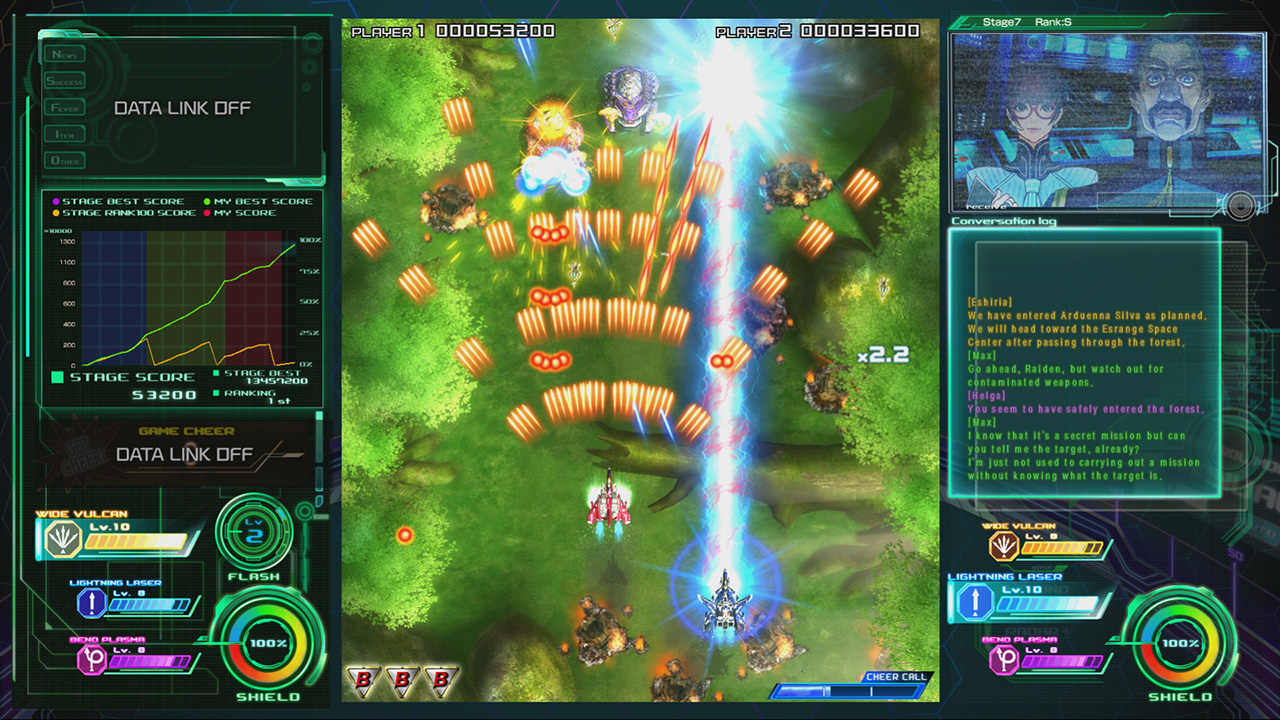
In standard fashion, these gadgets will keep your stats like score, flash level, the dialogue and even hi-score statistics. Your left gadget can even be cycled between the score chart and cheer notification, in-game tips and global statistics. Out of those, the tips are definitely the winners. They do give some important advice, such as staying on top of the guns of the first boss to avoid damage.
Not a friendly neighborhood
Every stage is divided into smaller scenes. These scenes serve as a way to catch your breath and tally your score. There’s even a nifty “restart scene” option that allows you to replay a scene. Choosing to restart will deny you the option to upload your score to the leaderboard, but serves as a great way to practice or even “fix” a run to so can get to the true ending.
Every once in a while, the action will pan out and open the way to a bigger stage, with you looking smaller in comparison. I admire the grandioseness of the resulting scenes, but they were also quite impractical. Think about your weapons, the destruction rate and the flash gauge. An extended stage means longer travel distances from side to side. Having a bigger stage means you move slower, which reduces the pacing of the game to a crawl. Reaching enemies quickly becomes a struggle. Worst yet, I’ve counted times where it took me whopping 5 seconds to go from side to side of the stage.
The OG bullet hell
Despite all the fun of blasting enemies quickly to gain flash levels, I gotta say that I found the combat, specifically the bullets, to be lacking in grace. For a game that’s the original bullet hell, most enemy volleys feel like bullet showers. There’s no finesse in them, just a bunch of bullets moving towards you. Dodging them isn’t fun, it’s survival. The problem only gets worse in higher difficulties where the bullets just go faster.
Not all patterns are as bad though. While the vast majority will be just a bunch on increasingly faster bullets thrown at you, some exceptional patterns will show from time to time. As a result, fights tend to be very hit or miss, with both hits and misses being on their respective extremes.
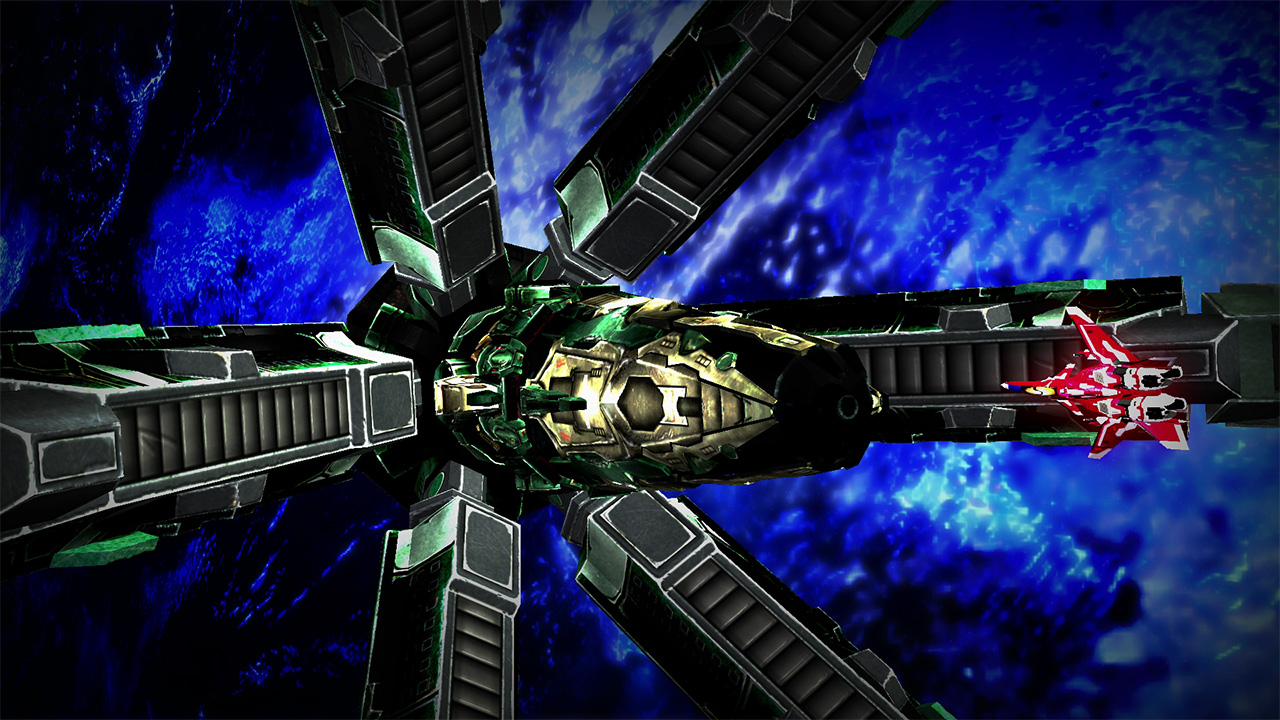
What certainly doesn’t help is that the bullets are very hard to see. As pretty as the backgrounds might be, they are very busy and the quick motion makes them into a blur. Bullets don’t have their characteristic outlines or color palettes to become distinguishable. Some even blend with your own vulcan. The result is a lot of cheap kills caused by intentional obfuscation. It this was their intention, then perhaps I’m being too harsh, but you know visibility is usually one of my pet peeves in shmups.
Replayability and longevity
As far as game length goes, I consider Raiden V to be one of the longer ones. I was surprised after my first run of the game, as it took me 50+ minutes to complete the campaign. Usually, my baseline for shmups is around half an hour, which made this one almost twice as long. While I’m not fond of longer campaigns, I know a lot of people would certainly be glad to know there is plenty of content.
Of course, playing through the campaign isn’t enough to view the entire game. If you recall, most stages have 4 versions of themselves. Those versions are separated by the ranks: S/A/B/C. This means you would need at least 4 runs to see everything the game has to offer. There’s also 6 different endings to uncover.
Also new to the Director’s Cut edition are 2 bonus levels. These level are slightly different from your typical levels. The bonus missions will challenge you to fight a new boss ir oder to obtain medals. Dealing damage will detach the medals from the boss, allowing you to catch them. Gather enough medals and you will advance to the next phase. Higher medals mean higher ranking. Taking damage will take medals away from you, so surviving continues to be a priority.
Lastly, there is a new boss mission mode that allow you to play “boss rush” missions. These missions have certain conditions, like using a specific weapon or fighting at a specific HP level. The targets are usually 1-3 bosses. Boss mission is a very fun arcadey mode for those who enjoyed the boss fights and want more of them.
Sound excellence
If there’s a factor that merits my highest praise is the sound department. Simply put, the OST is fantastic. The track length syncs perfectly with the stages, and it always fits the mood. I just couldn’t get enough of the OST, and listening to it while writing this review was the recipe for a perfect Sunday! I also got some good coffee that would make the captain proud.
For all the praise the music gets from me, it still is dragged down by the terrible sound mixing. Similarly to the voice acting, I tried to mess with the sound settings to increase the volume and reduce the sound effects, but it still wasn’t enough. The tracks were great but I struggled to listen to them amidst all the explosions. The calm moments were great, as they let me listen to the songs in peace.
Last words
Raiden is a master class in shmup design for the wrong reasons. Its high points perfectly illustrate how shmups should look and feel. The low points also show what you should NOT do when creating a shmup game. Despite all of this, it all comes down to how fun a game is.
Raiden V is a very fun game. It isn’t different, but it’s certainly very polished. I delivers some levels of quality that are notably absent in the majority of the games. As a concept, I feel like it serves as an example of how current gen shmups should be. The execution fell flat in some regards, but as a whole I was satisfied with the time I spent with the game. It does come with a hefty price tag, so my advice is to check this game out when you find a decent sale. I got mine at -70%.
THE RANKING SO FAR:
- Ikaruga
- Psyvariar Delta
- Darius Cozmic Collection Arcade
Devil Engine- Rolling Gunner
- Blazing Star
- Jamestown+
- Raiden V: Director’s Cut
- Darius Cozmic Collection Console
- Tengai
- Steredenn: Binary Stars
- Stardust Galaxy Warriors: Stellar Climax
- Sky Force: Reloaded
- Strikers 1945
- Black Paradox
- R-Type Dimensions EX
- Sine Mora EX
- Shikhondo – Soul Eater
- Ghost Blade HD
- AngerForce: Reloaded
- Aero Fighters 2 (ACA Neogeo)
- Q-YO Blaster
- Lightening Force: Quest for the darkstar (Sega Ages)
- Pawarumi
- Red Death
- Task Force Kampas
- Switch ‘N’ Shoot
- Last Resort (ACA Neogeo)
